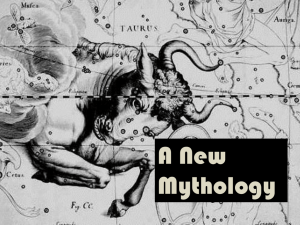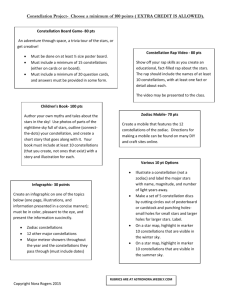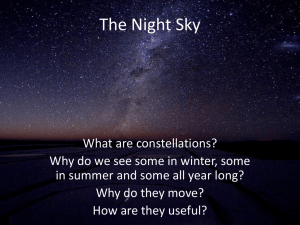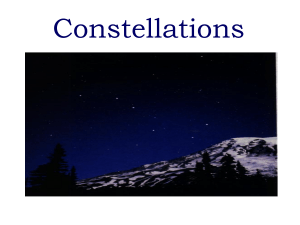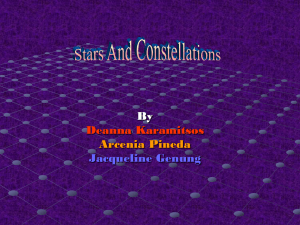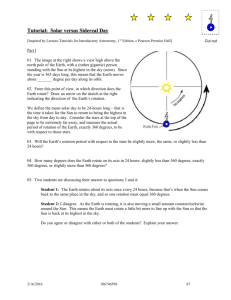Toys Watch the Sky - The Sun is a close star
advertisement
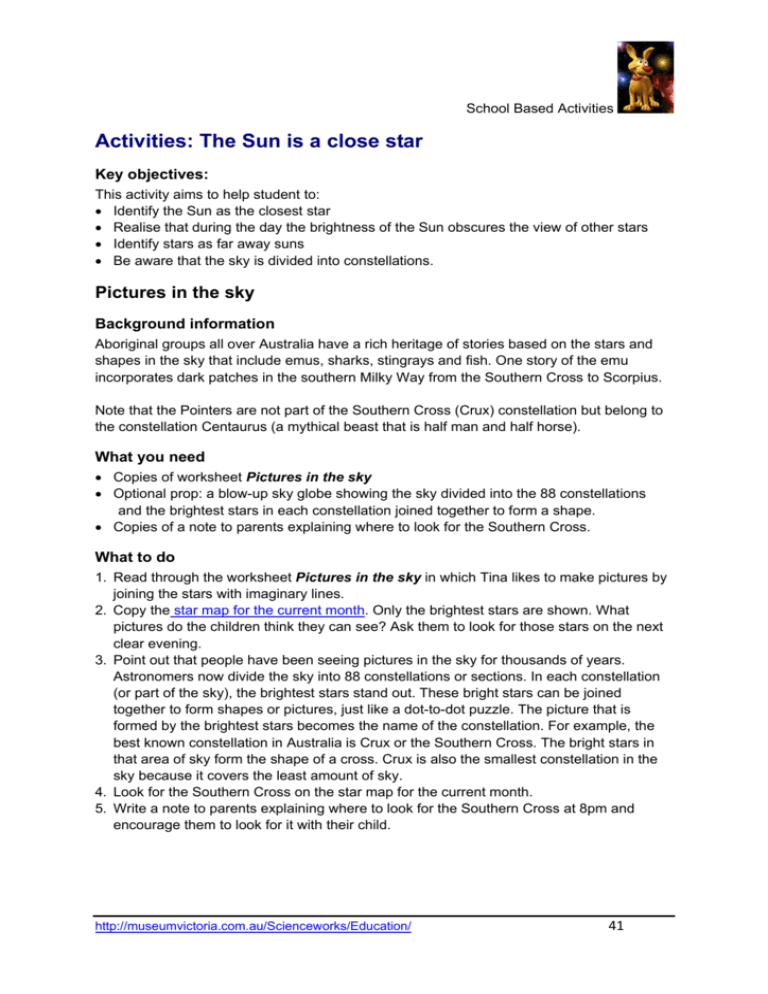
School Based Activities Activities: The Sun is a close star Key objectives: This activity aims to help student to: • Identify the Sun as the closest star • Realise that during the day the brightness of the Sun obscures the view of other stars • Identify stars as far away suns • Be aware that the sky is divided into constellations. Pictures in the sky Background information Aboriginal groups all over Australia have a rich heritage of stories based on the stars and shapes in the sky that include emus, sharks, stingrays and fish. One story of the emu incorporates dark patches in the southern Milky Way from the Southern Cross to Scorpius. Note that the Pointers are not part of the Southern Cross (Crux) constellation but belong to the constellation Centaurus (a mythical beast that is half man and half horse). What you need • Copies of worksheet Pictures in the sky • Optional prop: a blow-up sky globe showing the sky divided into the 88 constellations and the brightest stars in each constellation joined together to form a shape. • Copies of a note to parents explaining where to look for the Southern Cross. What to do 1. Read through the worksheet Pictures in the sky in which Tina likes to make pictures by joining the stars with imaginary lines. 2. Copy the star map for the current month. Only the brightest stars are shown. What pictures do the children think they can see? Ask them to look for those stars on the next clear evening. 3. Point out that people have been seeing pictures in the sky for thousands of years. Astronomers now divide the sky into 88 constellations or sections. In each constellation (or part of the sky), the brightest stars stand out. These bright stars can be joined together to form shapes or pictures, just like a dot-to-dot puzzle. The picture that is formed by the brightest stars becomes the name of the constellation. For example, the best known constellation in Australia is Crux or the Southern Cross. The bright stars in that area of sky form the shape of a cross. Crux is also the smallest constellation in the sky because it covers the least amount of sky. 4. Look for the Southern Cross on the star map for the current month. 5. Write a note to parents explaining where to look for the Southern Cross at 8pm and encourage them to look for it with their child. http://museumvictoria.com.au/Scienceworks/Education/ 41 School Based Activities Orion Scorpius Crux http://museumvictoria.com.au/Scienceworks/Education/ 42 School Based Activities Star light star bright Background information As a rule of thumb, the constellation of Orion can be seen during summer evenings and Scorpius during winter evenings. It is found low in the eastern sky in the evening from December, it sits overhead throughout February and becomes low in the western sky by April. The constellation of Scorpius is visible low in the eastern sky in the evening from May, appears overhead during August and sinks low in the western sky by November. The two constellations appear in opposite parts of the sky and at certain times one can be seen rising as the other one sets. One myth states that Orion was killed by the poisonous sting of the scorpion, which is why Orion now keeps out of Scorpius' way. What you need • • • • • • • • Copies of worksheet Daytime star Copies of worksheet Constellations in a cup Polystyrene cups Skewers Scissors Paste Torches (one per pair) Access to darkened room What to do 1. Make sure each student has a polystyrene cup, a skewer and a photocopy of the worksheet Constellations in a cup. 2. Cut out the cup constellation of Orion (for December - April) or the cup constellation of Scorpius (for May - November) or either for spring and autumn. Paste the constellation, face up, onto the inside bottom of the cup. 3. Cut out one of the cup constellations (see below), and paste it, face up, onto the inside bottom of the cup. Make small holes where the dots are by carefully pushing a pin or skewer through the dots one at a time. Make larger holes in the positions where there are larger dots (representing brighter stars). 4. The cups are now ready to be tested to see if the constellation can be seen. 5. Darken a room or area that has a clear wall. Put the torch in the cup and shine it onto the wall. The constellation should appear as dots of light on the wall. For best results the cup (with the torch inside) needs to be quite close to the wall. 6. The darkened room simulates night and when the room lights are turned on it represents day. Discuss what happens to the constellations when the light comes on even if the students keep their torches on. 7. Read the worksheet Daytime star. Ask the children to write their toy’s reason why the stars seem to disappear. 8. Encourage the children to look for their cup constellation in the evening sky. http://museumvictoria.com.au/Scienceworks/Education/ 43 School Based Activities A close star Background information The Sun is a huge ball of glowing gases (mostly hydrogen and helium). It is the star at the centre of our Solar System. The Sun is located in an outer spiral arm of the Milky Way Galaxy, approximately 28,000 light-years from the galaxy's centre. (One light year is about 10 million million km.) In comparison with other stars, our Sun is very ordinary – it’s an average sized (1.4 million km in diameter), middle aged (at least five billion years old) yellow star. The hottest stars are blue/white and the coolest stars are red. Many constellations were named in ancient times and associated with myths and legends. Others however, especially those in the southern sky, are modern (15th and 16th centuries), such as Telescopium (the telescope) and Pyxis (the compass). What you need • Copies of worksheet Daytime star • Two bright torches • Access to a corridor/passageway What to do 1. Re-read the worksheet Daytime star. 2. Sit the class in a passage way or corridor. 3. Take two identical torches and check that they are of the same brightness. (It's a good idea to replace older batteries). 4. Have one torch shining into the students faces at close range and the other at the far end of the passage way. 5. Discuss the different appearance of the torches and relate this to the fact that our Sun looks brighter because it is closer. Extension activities What you need • Art paper • Food dyes or paints • Black paper What to do • Investigate other constellations: how they were named and the legends they relate to. • Make sunrise/sunset pictures. Look at some photographs of spectacular sunsets/sunrises. Using bright orange and yellow food dye, create a streaked sky covering the whole sheet. As it dries, cut out silhouettes of trees, fences, houses, etc. to paste in the foreground. http://museumvictoria.com.au/Scienceworks/Education/ 44 School Based Activities Worksheet – Photocopy this page. Pictures in the sky “Look at all those stars twinkling. It’s so beautiful,” sighed Nellie. “I like to pretend to join the stars together to make pictures,” added Tina. “What can you make from those stars?” I think it’s … ______________________________________________ ______________________________________________ ______________________________________________ ______________________________________________ ______________________________________________ http://museumvictoria.com.au/Scienceworks/Education/ 45 School Based Activities Worksheet – Photocopy this page. Daytime star “Our Sun’s a star, you know,” said Scarecrow. “It’s just a lot closer than the other stars, so it looks a lot brighter.” “It’s like those car headlights. The ones coming up the driveway look very big and bright, but the ones down the road are small, even though they really are the same,” added Tina. “I’d like to know where all those stars go to during the day,” said Oscar. Well …. ______________________________________________ ______________________________________________ ______________________________________________ ______________________________________________ ______________________________________________ http://museumvictoria.com.au/Scienceworks/Education/ 46 School Based Activities Worksheet – Photocopy this page. Constellations in a cup Orion Scorpius Crux http://museumvictoria.com.au/Scienceworks/Education/ 47

